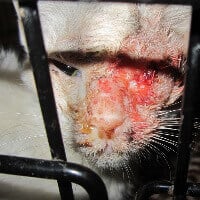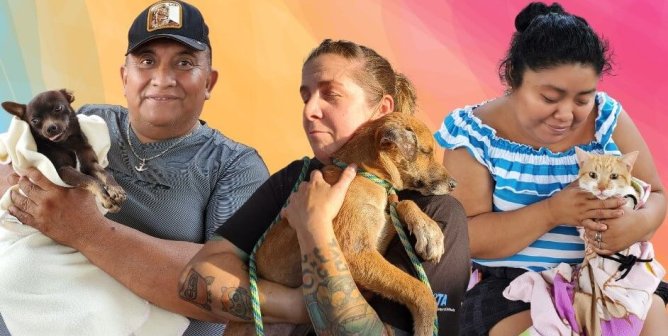If you’ve ever spent time volunteering at an animal shelter, you’ve seen it: the endless stream of dogs and cats—scared, lonely, and confused—aching for a kind word or a reassuring touch. Some of them have been relinquished by their guardians, while others have been rescued from the streets, but they all have one thing in common: They’re victims of the companion animal overpopulation crisis.
On any given day, an estimated 70 million homeless dogs and cats are struggling to survive on the streets, where they face dangers such as parasites, predators (including cruel humans), extreme temperatures, speeding cars, and contagious diseases. Under pressure from misinformed people who have been duped by “no-kill” crusaders like Nathan Winograd, a growing number of animal shelters have begun to turn many animals away. Only an estimated 10% of the large homeless-animal population is admitted to animal shelters each year. Of the millions of those who do enter shelters, about half must be euthanized as a result of severe neglect or abuse; because they’re sick, injured, elderly, aggressive, or unsocialized; or because no suitable homes exist for them.
These statistics alone show the severity of our country’s companion animal overpopulation crisis. Yet Winograd, a so-called animal advocate, is trying to convince the public that animal overpopulation doesn’t exist.
Nathan Winograd Misplaces Blame
In his crusade to make all animal shelters “no-kill,” Winograd blames the shelter workers—who have devoted their lives to caring for homeless animals, giving them a chance at a home and providing them with a painless death when no other humane alternative exists—for the euthanasia of millions of animals every year. This is akin to blaming hospitals for deadly diseases. This false “logic” absolves the real culprits: people who breed (or fail to spay or neuter) their animals and people who buy animals from pet stores or breeders instead of adopting homeless animals from shelters. No one wants to see animals euthanized—least of all those who have to euthanize them—but denying that a crisis exists and blaming those who are doing their best to help end it is vicious and solves nothing. In fact, it misleads the public into believing that there is no need for change—a dangerous misrepresentation of facts that leads only to more animal suffering.
Too Many Animals, Too Few Homes
What Winograd espouses altogether ignores the hundreds of thousands of puppies and kittens produced by breeders and sold in pet stores every year as well as the millions of homeless animals barely eking out an existence across the country. When these animals are added to the millions who enter shelters each year, the number of those in need of homes far exceeds the number of homes that are theoretically available to them. What’s more, not all households that consider acquiring a cat or dog (or even all those that currently have animals) are responsible homes that would pass a shelter’s minimal screening requirements.
The Key to a ‘No-Kill’ Nation: A No-Birth Nation
Our goal is a future in which no animal must be euthanized for lack of a good home, but that time will only come if we stop the problem at its source, by ensuring that animals are spayed or neutered to prevent more of them from being born. Even if we could somehow find homes for the more than 6 million cats and dogs who will enter U.S. animal shelters this year, what about the 6 million next year and the year after that? And what about the 70 million animals who are struggling to survive on the streets—being hit by cars; sickened from eating garbage and drinking from polluted puddles; eaten alive by fleas, worms, and maggots; struggling to breathe because of severe upper respiratory infections; and suffering in countless other ways? Let’s stop this cycle by always having animal companions sterilized and never buying them from a breeder or pet store.
Crowded Cages, Disease, and Death
Many animal shelters have been bullied into implementing harmful policies and practices in an attempt to pad their “save rates.” This intimidation comes from small but vocal groups of people masquerading as “experts”—some of whom have been misled by Winograd’s false logic—who pressure and threaten shelters and public officials into avoiding euthanasia at all costs.
Some “no-kill” crusaders have been known to attack shelter workers, spread lies about them, and even threaten to kill them, which has caused some seasoned shelter experts to retire. Many shelters have caved to this pressure and resorted to turning animals away, ending the intake of feral or free-roaming cats, charging people high fees to surrender animals, and implementing other policies that put animals in danger.
Here are some examples:
- After the SPCA of Tompkins County in New York—where Winograd served as executive director and implemented a “no-kill” policy—became extremely crowded, it began accepting animals by appointment only and stacked animals in cages throughout the facility, including in the laundry room and kitchen. According to a subsequent shelter director, the facility slashed its adoption fees and lowered its standards for the homes in which it places animals—significantly increasing the risk of abuse and neglect—in an effort to move more animals out the door. The organization has also turned away animals because of disease outbreaks in the facility.
- At the Austin, Texas, city animal shelter that’s frequently touted as a model by “no-kill” campaigners, service is stopped almost as frequently as its nearly $12 million annual budget is increased. A 2015 city audit found that it was so severely crowded that workers weren’t spending enough time on animal care or responding quickly enough to calls about aggressive, stray, or injured animals. In order to maintain its “no-kill” status, the city shelter also transferred hundreds of dangerous dogs, including many who had been involved in attacks that had caused “severe” injuries to people, to be adopted to unsuspecting members of the public.
- The owner of Angel’s Gate animal hospice in New York was charged with cruelty to animals months after investigators searched the facility. The official investigation was prompted by an undercover PETA investigation, which documented that paralyzed dogs were dragging themselves around until they developed bloody skin ulcers while their wheeled carts hung on a fence unused, animals with open wounds and respiratory infections were deprived of veterinary examinations and care, and animals were kept in diapers for several days, causing urine scald.
Cases like these abound when shelters are pressured to prioritize statistics over individual animals’ welfare.
Turning Animals Away
Promoting adoptions, using foster homes and volunteers, and encouraging guardians to work through behavioral issues or other problems that may otherwise cause them to relinquish their animals are all good policies that every shelter should follow. But when capacity has been reached and there’s no place to put even one more animal, what does a “no-kill” shelter do? Most simply refuse to take animals in, which leaves them at the mercy of people who don’t want them.
This, too, often results in tragedy:
- A Virginia woman who was convicted of cruelty to animals in the shooting deaths of six puppies testified that “she was angry and frustrated that even though she tried to do the right thing, she wasn’t able to find a place for the animals.” She reportedly contacted two shelters, but one was full and the other wouldn’t take the puppies because they belonged to her son. The woman said that she then shot them to death and disposed of their bodies.
- After a kitten was turned away from a public animal shelter in Florida, he was abandoned in the facility’s parking lot, where he was run over and his skull was crushed. He died after languishing in a cage for days.
- A Pennsylvania man was charged with aggravated cruelty to animals for allegedly strangling his dog to death and burying the body in his backyard. The man said that the dog had stopped eating and was vomiting and having diarrhea. He took the dog to the SPCA, where the animal vomited in the office. The man was allegedly told to take the dog to a veterinary hospital for treatment, but he didn’t have the money to do so. A necropsy found bruising encircling the dog’s neck, which indicated strangulation as the cause of death.
- A Texas man tried to turn in two puppies to a self-professed “no-kill” facility but was turned away and told to take them to a public shelter. Hours later, the dogs were found “in a trash dumpster behind a grocery store . . . about 100 yards away.” They were “covered in fleas, had ringworm, tested positive for worms and one had parvovirus.”
- A Florida woman reportedly tried to surrender a malnourished dog to a self-professed “no-kill” facility but was turned away. She became angry, shoved the dog into the trunk of her car, and drove off. According to a spokesperson for the facility, after the woman was told that it was full, she asked whether the dog could be euthanized there and was told “to go to another shelter.” Surveillance footage showed that she had transported the dog in the trunk of her car both to and from the facility. Authorities were called, and they found the dog at the woman’s residence, where she was evidently arrested and charged with cruelty to animals.
It’s true that “no-kill” shelters don’t euthanize animals, but by turning them away, they sometimes condemn animals to terrifying, painful, and violent deaths. Socially conscious, open-admission shelters accept every dog, cat, bird, rabbit, hamster, rat, or other animal who comes through their doors. They don’t pick and choose, accepting only the young, healthy, behaviorally sound ones who might be quickly adopted. They pledge to help every animal in need, even when the best they can offer is a painless release from an uncaring world. Please support open-admission shelters and help end the need to euthanize animals for lack of good homes by having your animals spayed or neutered and by urging everyone you know to do the same.







